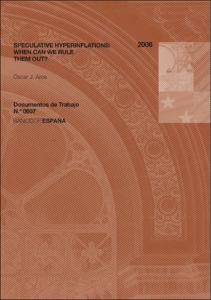Registro completo de metadatos
| Campo DC | Valor |
|---|---|
| dc.contributor.author | Arce, Óscar |
| dc.date.accessioned | 2019-08-10T17:47:17Z |
| dc.date.available | 2019-08-10T17:47:17Z |
| dc.date.issued | 2006-04-03 |
| dc.identifier.issn | ISSN: 0213-2710 (en papel) |
| dc.identifier.issn | ISSN: 1579-8666 (en línea) |
| dc.identifier.uri | https://repositorio.bde.es/handle/123456789/6862 |
| dc.description.abstract | Motivated by a strong degree of hysteresis in the stock of monetization observed after the end of hyperinflations, I provide a cash-and-credit model in which the use of money exhibits some persistence because individuals can establish long-lasting credit relationships. This feature helps to account for the main stylized facts of extreme hyperinflations and reconcile some conflicting views on their causes, development and end without departing from rational expectations. Unlike the existing literature, I show that when hysteresis is possible, an orthodox fiscal-monetary reform that successfully stops a speculative hyperinflation may not be sufficient to prevent it. [resumen de autor] |
| dc.format.extent | 46 p. |
| dc.language.iso | en |
| dc.publisher | Banco de España |
| dc.relation.ispartof | Documentos de Trabajo / Banco de España, 0607 |
| dc.rights | Reconocimiento-NoComercial-CompartirIgual 4.0 Internacional (CC BY-NC-SA 4.0) |
| dc.rights | In Copyright - Non Commercial Use Permitted |
| dc.rights.uri | https://creativecommons.org/licenses/by-nc-sa/4.0/deed.es_ES |
| dc.rights.uri | http://rightsstatements.org/vocab/InC-NC/1.0/ |
| dc.subject | Fiscal-Monetary Reform |
| dc.subject | Multiple Equilibria |
| dc.subject | Hysteresis |
| dc.title | Speculative hyperinflations : when can we rule them out? |
| dc.type | Documento de trabajo |
| dc.identifier.bdebib | 000186605 |
| dc.identifier.bdepub | DTRA-200607-eng |
| dc.subject.bde | Teoría monetaría |
| dc.subject.bde | Renta, empleo y precios |
| dc.subject.bde | Política monetaria |
| dc.publisher.bde | Madrid : Banco de España, 2006 |
| dc.subject.jel | E31 |
| dc.subject.jel | E41 |
| dc.subject.jel | E63 |












